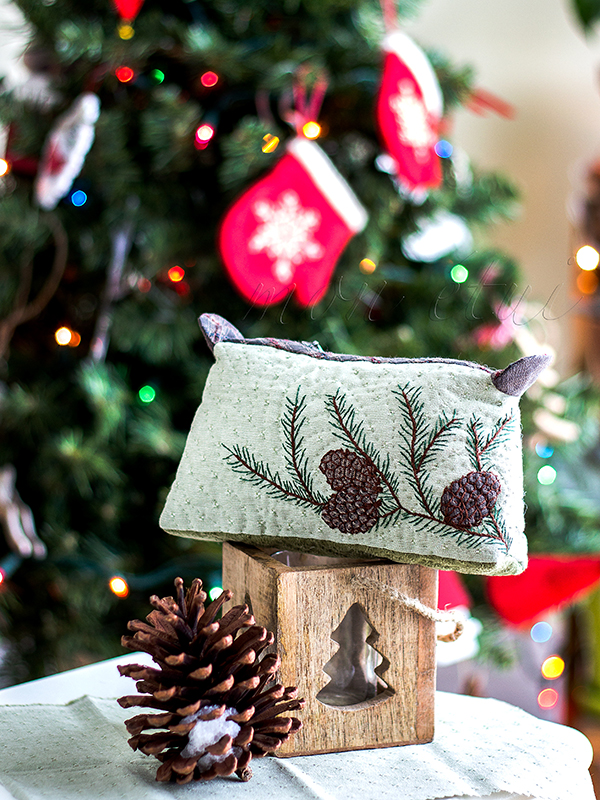How-To
Here is the recipe for the wine bottle gift bag:
materials used:
31 cm x 35 cm Haori yarn-dyed cotton fabric for the face
12 cm x 24 cm Haori yarn-dyed cotton fabric for the bottom pieces of the bag
(I used the fabric, used for the face)
31 cm x 43 cm Haori yarn-dyed cotton fabric for the liningpieces of fabric for desired appliqué (optional)
Haori 100% polyester thread in matching colours
12 cm x 12 cm heavy interfacing
2 cork bottle stoppers
jute cord
1. Prepare all the appliqué pieces that will be used (optional). I machine-stitched a graphic cheese board on an ivory background and used cut-out shape of wine bottle with hand-stitched label, matching the original wine bottle. You could make whatever you are pleased to do, or just sew a plain wine bottle bag.
2. Decide how you would position the appliqués (if used), where the side seem would be and where the openings for the cord would be stitched. Attach the desired designs to the piece of fabric, used for the face.
Note: Make sure that when folded in the middle, your designs will fall on the side that you want them to be. I wanted the bottle design to fall on the front left bottom "corner"of the bag and the cheese board to cover the back bottom side. The side seem I chose to be on the right side of the bag. The openings for the cord I decided to be on the top left side of the front ( almost opposite to the side seam, so the cork stoppers fall on the left of the appliquéd bottle). If you wish to have the seem on the back, reposition your appliqués.
3. Cut out the bottom pieces.
These are the exact measurements for the bag I made, using this particular wine bottle. Wine bottles on the market are pretty standard, but make sure that you measure yours first and that these measurements would fit your needs. I made the bag pretty fitted for cleaner look.
30.5 cm x 34.5 cm (12" x 13.5") face
30.5 cm x 43.0 cm (12" x 17.0") lining
10 cm diametre for the bottom circled pieces
4. With right sides together, pin the face and lining fabric and stitch at the top. Turn them right side(s) out and even the bottom edges in a way, that the lining fabric stands higher then the face fabric. Press with an iron to form the top edge of the bag. This will help you decide where to stitch the holes for the cord.
5. Hand-stich the openings for the cord on the facing fabric, just below the seam. Use a blanket stitch, open a bit at the bottom, but very closed at the top edge to form a ring. Press.
8. Stich all the way along the 'sleeve', leaving an opening of 8-10 cm somewhere on the lining piece, closer to the bottom. I worked with 10 mm seam. Trim a bit (to 7 mm seam).
10. Starting with the interfaced piece for the lining, pin all the way from the centre to the edge to keep the piece in place. Stitch. Repeat in a same manner for the other side of the 'sleeve'.
12. Turn the 'sleeve right side out through the opening, left on the side of the lining. Press the seams around the closed 'sleeve' openings.
14. Holding the ironed top edge that you have formed in step 4, push the bottom of the lining through the 'sleeve' all the way until you meet the bottom piece of the face. Adjust the edges of both round pieces to match. Straighten the sleeve all the way up to form the bag. Press. Because of its skinny shape and round bottom, the bag stays on its own, even when it is empty.
15. Make the channel for the cord: Stitch over the seam that connects the lining and the facing fabric. Make a seam below the hand-stitched holes for the cord. With seam ripper, gently cut the holes open, without damaging the stitching.
prepare the cord:
1. Use a wide eyed needle, longer than the cork stopper. Thread the needle with the jute cord. Make sure you 'stitch' in the centre of the cork stopper and the needle is going perfectly straight. The cork is a very 'alive' material, it forms a tight hug to any object it is in contact with, that is why the movement of the needle is very hard. You may need to press it against a wooden board. Once the top of the needle starts coming out, pull hard to take it out completely through the cork. It is not an easy task, but possible. Tie a not at the end of the cork stopper.
2. Cut off the desired length of the cord. I used a long cord, because I wanted to tie it around few times.
3. Thread the needle with the other end of the cord and very carefully, with the needle as a guide, starting from one of the cord openings on the bag, insert the cord into the sewn casing, going around and ending out the other hand-stitched hole. Pull the cord and attach the second cork stopper.
4. Tie the bag around the top of the bottle. Make your friends happy!
Cheers, friends!
♥ Ivelina



























































